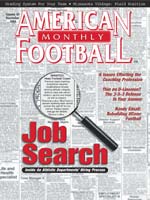AMERICAN FOOTBALL MONTHLY THE #1 RESOURCE FOR FOOTBALL COACHES
Article CategoriesAFM Magazine
|
6 Issues That May Be Effecting YouIn an exclusive interview with The American Football Coaches Association’s Executive Director, Grant Teaff takes aim at six issues in today\'s high-pressure world of coachingby: Steve Silverman © More from this issue In the early part of the 20th century, there was a loud hue and cry to ban football. The game was violent, dangerous and apparently out of control. President Teddy Roosevelt had decided it was a brutal activity. There had been many deaths in one year. Football coaches who would soon find themselves out of a job took it upon themselves to clean up the game and make it acceptable. They rewrote the rules, got rid of the flying wedge – a system of blocking that basically maimed and injured opponents – and brought the game on a path that would lead to acceptance by the public. The forward pass came into existence and the rules committee would ultimately morph into the National Collegiate Athletic Association. They later went on to form their own coaches association, which is now calle....The full article can only be seen by subscribers. Subscribe today!
|
|
|||||||
| HOME |
MAGAZINE |
SUBSCRIBE | ONLINE COLUMNISTS | COACHING VIDEOS |
Copyright 2025, AmericanFootballMonthly.com
All Rights Reserved





